21 found, showing page 1 of 2
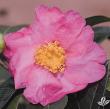
This variety has a compact, upright growth habit, reaching 4-5' tall and 2-3' wide at maturity. Produces single, pink flowers in mid-fall.
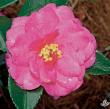
Shishigashira' produces dark-pink, semi-double blooms with golden-yellow stamens in the center. Slowly reaches 4-5' tall and 6-8' wide.

This variety keeps a compact habit, growing 2-3' tall and wide. Deep-pink flowers.

Height: 15 feet
Spread: 15 feet
Sunlight: full sun partial shade
Hardiness Zone: 6a
Other Names: Crape Myrtle, Crepe Myrtle
Description:
This exceptionally cold hardy, semi-dwarf variety is covered in frilly pink blooms in summer, followed by deep red fall foliage; a captivating focal point for the garden or border
Ornamental Features:
Hopi Crapemyrtle is clothed in stunning panicles of pink frilly flowers at the ends of the branches from early to late summer. It has attractive dark green deciduous foliage which emerges coppery-bronze in spring. The oval leaves are highly ornamental and turn dark red in fall.
Landscape Attributes:
Hopi Crapemyrtle is a dense multi-stemmed deciduous shrub with a more or less rounded form. Its relatively fine texture sets it apart from other landscape plants with less refined foliage.
This is a relatively low maintenance shrub, and is best pruned in late winter once the threat of extreme cold has passed. It has no significant negative characteristics.
Hopi Crapemyrtle is recommended for the following landscape applications:
- Accent
- Mass Planting
- Hedges/Screening
- General Garden Use
- Container Planting
Planting & Growing:
Hopi Crapemyrtle will grow to be about 15 feet tall at maturity, with a spread of 15 feet. It has a low canopy with a typical clearance of 2 feet from the ground, and is suitable for planting under power lines. It grows at a fast rate, and under ideal conditions can be expected to live for 50 years or more.
This shrub does best in full sun to partial shade. It prefers to grow in average to moist conditions, and shouldn't be allowed to dry out. It is very fussy about its soil conditions and must have rich, acidic soils to ensure success, and is subject to chlorosis (yellowing) of the foliage in alkaline soils. It is highly tolerant of urban pollution and will even thrive in inner city environments. This particular variety is an interspecific
hybrid.
Hopi Crapemyrtle makes a fine choice for the outdoor landscape, but it is also well-suited for use in outdoor pots and containers. Because of its height, it is often used as a 'thriller' in the 'spiller-thriller-filler' container combination; plant it near the center of the pot, surrounded by smaller plants and those that spill over the edges. It is even sizeable enough that it can be grown alone in a suitable container. Note that when grown in a container, it may not perform exactly as indicated on the tag - this is to be expected. Also note that when growing plants in outdoor containers and baskets, they may require more frequent waterings than they would in the yard or garden.
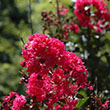
The 'Pink Velour' has an upright, rounded growth habit and will reach 10-12' tall and wide at maturity. It produces large plumes of vibrant, pink blooms that persist through summer. New foliage emerges burgundy red and ages to dark green.
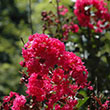
The 'Pink Velour' has an upright, rounded growth habit and will reach 10-12' tall and wide at maturity. It produces large plumes of vibrant, pink blooms that persist through summer. New foliage emerges burgundy red and ages to dark green.

Height: 3 feet
Spread: 3 feet
Sunlight: full sun partial shade
Hardiness Zone: 6b
Other Names: Crape Myrtle, Crepe Myrtle
Description:
Pretty papery panicles of pink flowers cover this miniature crapemyrtle; shows good resistance to powdery mildew; heat and drought tolerance; does not like to be over-fertilized
Ornamental Features:
Pocomoke Crapemyrtle is draped in stunning panicles of pink frilly flowers at the ends of the branches from early to late summer. It has attractive dark green deciduous foliage which emerges coppery-bronze in spring. The oval leaves are highly ornamental and turn orange in fall.
Landscape Attributes:
Pocomoke Crapemyrtle is a dense multi-stemmed deciduous shrub with a mounded form. Its relatively fine texture sets it apart from other landscape plants with less refined foliage.
This is a relatively low maintenance shrub. Trim off the flower heads after they fade and die to encourage more blooms late into the season. Deer don't particularly care for this plant and will usually leave it alone in favor of tastier treats. It has no significant negative characteristics.
Pocomoke Crapemyrtle is recommended for the following landscape applications:
- Mass Planting
- Rock/Alpine Gardens
- General Garden Use
- Groundcover
- Container Planting
Planting & Growing:
Pocomoke Crapemyrtle will grow to be about 3 feet tall at maturity, with a spread of 3 feet. It tends to fill out right to the ground and therefore doesn't necessarily require facer plants in front. It grows at a fast rate, and under ideal conditions can be expected to live for approximately 20 years.
This shrub does best in full sun to partial shade. It prefers to grow in average to moist conditions, and shouldn't be allowed to dry out. It is very fussy about its soil conditions and must have rich, acidic soils to ensure success, and is subject to chlorosis (yellowing) of the foliage in alkaline soils. It is highly tolerant of urban pollution and will even thrive in inner city environments. This particular variety is an interspecific
hybrid.
Pocomoke Crapemyrtle makes a fine choice for the outdoor landscape, but it is also well-suited for use in outdoor pots and containers. Because of its height, it is often used as a 'thriller' in the 'spiller-thriller-filler' container combination; plant it near the center of the pot, surrounded by smaller plants and those that spill over the edges. It is even sizeable enough that it can be grown alone in a suitable container. Note that when grown in a container, it may not perform exactly as indicated on the tag - this is to be expected. Also note that when growing plants in outdoor containers and baskets, they may require more frequent waterings than they would in the yard or garden.

The 'Pocomoke' is a dwarf variety with a dense growth habit that will reach 3-5' tall and wide. Its dark green foliage ages to rich, burgundy-red in the fall. Blooms are rose-pink and will persist through the summer.
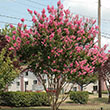
The 'Sioux' is a popular variety known for its large, vibrant-pink, panicle flowers that bloom profusely throughout the summer. This variety will quickly reach 15-20' tall and 12-15' wide. Multi-trunked with a dense, upright growth habit.

Leo' produces vibrant pink flowers with golden-yellow throats. Grows 6-12' long. Fragrant.
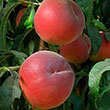
The 'Flavortop' is a dwarf variety that produces stunning fruit with rich, red skin and sweet, yellow flesh. It bears abundantly large crops, and produces even higher yeilds when paired with other varieties. Mature height will be 12-15' tall and wide. Beatiful pink flowers emerging in early spring add seasonal interest.
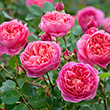
Height: 3 feet
Spread: 30 inches
Sunlight: full sun
Hardiness Zone: 4a
Other Names: English Rose
Group/Class: Austin Rose
Description:
An outstanding rose producing perfectly formed, upward facing coral blooms with small petals of varying shades; heavenly myrrh fragrance; needs full sun and well-drained soil; good disease resistance; very hardy with some protection
Ornamental Features:
Boscobel Rose is clothed in stunning fragrant coral-pink flowers with pink overtones at the ends of the branches from late spring to early fall, which emerge from distinctive red flower buds. The flowers are excellent for cutting. It has forest green deciduous foliage. The oval compound leaves do not develop any appreciable fall color.
Landscape Attributes:
Boscobel Rose is a multi-stemmed deciduous shrub with an upright spreading habit of growth. Its average texture blends into the landscape, but can be balanced by one or two finer or coarser trees or shrubs for an effective composition.
This is a high maintenance shrub that will require regular care and upkeep, and is best pruned in late winter once the threat of extreme cold has passed. Gardeners should be aware of the following characteristic(s) that may warrant special consideration:
- Disease
- Spiny
Boscobel Rose is recommended for the following landscape applications:
- Mass Planting
- Hedges/Screening
- General Garden Use
Planting & Growing:
Boscobel Rose will grow to be about 3 feet tall at maturity, with a spread of 30 inches. It tends to fill out right to the ground and therefore doesn't necessarily require facer plants in front. It grows at a fast rate, and under ideal conditions can be expected to live for approximately 20 years.
This shrub should only be grown in full sunlight. It does best in average to evenly moist conditions, but will not tolerate standing water. It is not particular as to soil type or pH. It is highly tolerant of urban pollution and will even thrive in inner city environments. This particular variety is an interspecific hybrid.

Fragrant Cloud' is a compact, bushy hybrid tea rose that grows 3-4' tall and 2-3' wide. Honey-sweet fragrance. Disease resistant.
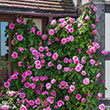
Gertrude Jeckyll' is a beautiful, English shrub rose that will reach 6-8' tall and 3-4' wide. Old-fashioned pink rosettes have rich, rosey fragrance. Good disease resistance.
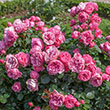
The 'Leonardo Da Vinci' rose is a low-spreading, landscape rose that grows 4-5' tall and 2-3' wide. It can be trained onto a trellis as a climber. Rich, rosy-pink, cup-shaped blooms have a mild, tea fragrance.
21 found, showing page 1 of 2